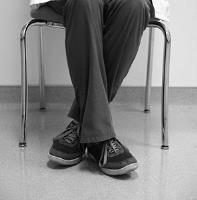What is syncope?
Syncope (pronounced "sin ko pee") is commonly called fainting or passing out. It is caused by a temporary decrease in blood flow to the brain. It can be related to a sudden drop in blood pressure, heart rate or changes in blood volume or distribution. When a person faints, they usually become conscious and alert right away, but they may be confused for a short time afterward.
Syncope is often a symptom of another medical condition that can be related to your heart, nervous system or blood flow to the brain.
If you have syncope, it is important for you and those close to you to know the signs and symptoms that can lead to fainting. Every patient is different, but common symptoms are feeling light-headed, nauseous, and having cold, clammy skin. If you feel these symptoms, counter-pressure techniques can prevent you from fainting. Practice these exercises even when you do not have symptoms of syncope so you know each technique.
Handgrip

Hold a rubber ball in the hand you use to write. Squeeze the ball for as long as you can or until your symptoms stop.
Arm-tensing

Grip one hand with the other and pull them against each other without letting go. Hold this grip as long as you can or until your symptoms stop.
Leg-crossing

Cross one leg over the other and squeeze the muscles in your legs, abdomen and buttocks. Hold this position as long as you can or until your symptoms stop.
Syncope research
The National Institute of Neurological Disorders and Stroke (NINDS) and other institutes of the National Institutes of Health (NIH) conduct research related to syncope in laboratories at the NIH. The organizations support additional research through grants to major medical institutions across the country. Much of this research focuses on finding better ways to prevent and treat syncope.
Organization information
National Heart, Lung, and Blood Institute (NHLBI)
National Institutes of Health, DHHS
31 Center Drive, Rm. 4A21 MSC 2480
Bethesda, MD 20892-2480
Phone: 301.592.8573
TTY: 240.629.3255
Recorded info: 800.575.WELL (9355)
Website: www.nhlbi.nih.gov
Reference: van Dijk N, Quartieri F, Blanc JJ, et al. Effectiveness of Physical Counterpressure Maneuvers in Preventing Vasovagal Syncope. J Am Coll Cardiol. 2006 Oct 17;48(8):1652-7. Epub 2006 Sep 26.